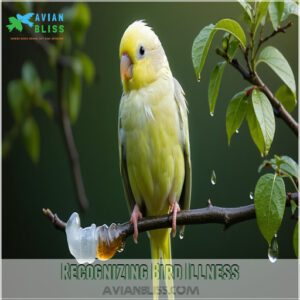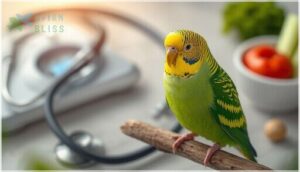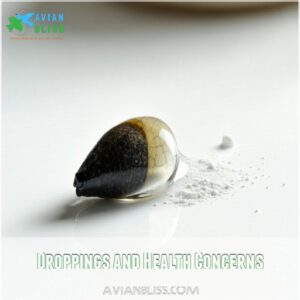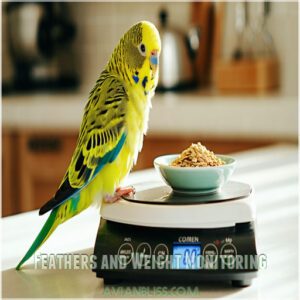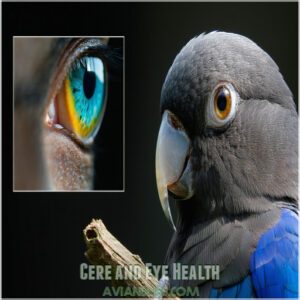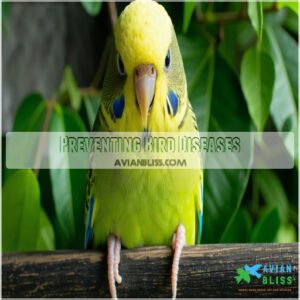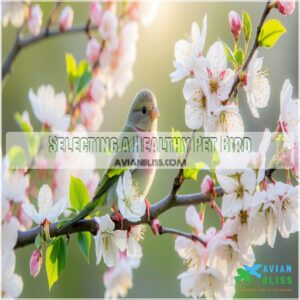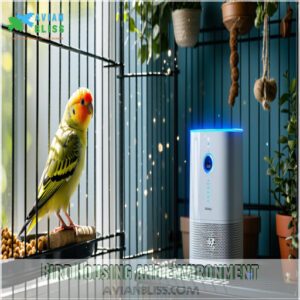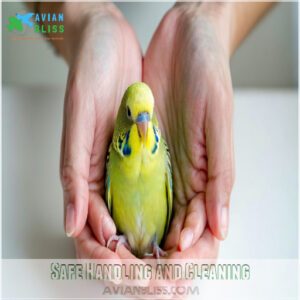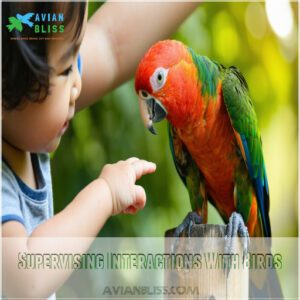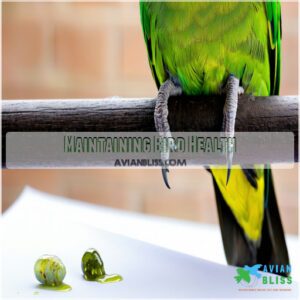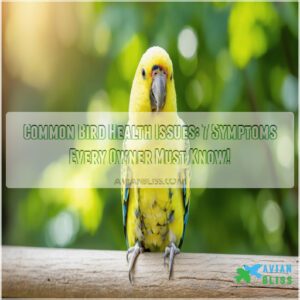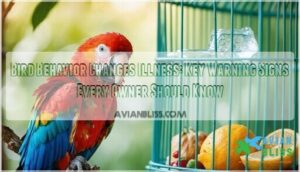This site is supported by our readers. We may earn a commission, at no cost to you, if you purchase through links.
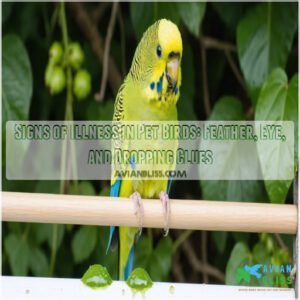
Watch for signs of illness in your pet bird: ruffled or messy feathers that stay puffed up, changes in eating habits, and unusual balance issues are red flags. Keep an eye out for respiratory problems like open-mouth breathing or nasal discharge.
Just like a friend having an off day, you’ll notice when your bird isn’t their usual chirpy self.
Quick action and prevention are your best allies – understanding subtle changes in behavior today can save you both from bigger worries tomorrow.
Table Of Contents
- Key Takeaways
- Recognizing Bird Illness
- Bird Health Indicators
- Preventing Bird Diseases
- Bird Care and Safety
- Maintaining Bird Health
- Frequently Asked Questions (FAQs)
- Can a pet bird make you sick?
- Are birds sick?
- How do you know if a bird is sick?
- What should I do if my bird is sick?
- Why is my pet bird sick?
- Why does my bird show symptoms of illness?
- How do you prevent bird sickness?
- How do I know if my bird has psittacosis?
- How do birds act when they are sick?
- Is it safe to sleep in the same room with birds?
- Conclusion
Key Takeaways
- Watch for physical changes in your bird’s appearance – if you notice ruffled feathers, messy plumage, eye discharge, or changes in the cere’s color, it’s time to consult a vet.
- Monitor your bird’s daily behavior – you’ll need to track their eating habits, droppings (color and consistency), balance, and energy levels to catch early signs of illness.
- Keep your bird’s environment clean and safe – you should maintain proper cage hygiene, ensure good ventilation, use dedicated cleaning supplies, and wash your hands thoroughly after handling your bird or its equipment.
- Don’t skip regular vet checkups – you’ll want to schedule health consultations every 6-12 months with an avian vet for preventative care and early disease detection, especially since birds often hide their ailments until they’re quite unwell.
Recognizing Bird Illness
As a bird parent, you play a pivotal role in your pet’s health.
Knowing the signs of illness in birds is essential for their well-being, as they often hide their ailments until they’re quite unwell.
Feather Changes and Health
A bird’s feathers are a tell-tale sign of its health.
Keep an eye out for these feather changes that could indicate your pet is under the weather:
- Ruffled Feathers: Might indicate respiratory issues or mask weight loss.
- Feather Loss: Could be due to plucking, preening issues, or illness.
- Dull, Altered Feather Coloring: May signal fever or infection.
- Messy Feathers: Suggests illness; keep an eye out for dirt or stains.
- Molting Issues: If feathers look chewed or damaged, something’s amiss.
Monitoring for general signs of illness is essential for early detection and treatment.
Physical Appearance Changes
Besides feather changes, pay attention to physical appearance clues.
Sick birds might fluff up their feathers, droop their wings, or have ruffled plumage.
Other signs include swollen eyes, a discolored beak, or puffing and ruffling feathers to mask weight loss.
These feather changes can indicate respiratory issues, illness, or attempts to stay warm.
A bird’s appearance speaks volumes, so keep an eye out for these subtle cues.
Movement and Balance Issues
If your feathered friend is struggling with movement and balance, it’s a cause for concern.
Keep an eye out for weakness, a telltale sign of illness.
Notice if your bird is losing balance, teetering, or falling off its perch.
Other red flags include wing tremors, walking in circles, and trembling.
If your bird is hanging onto the cage by its beak, it’s definitely time to see an avian vet.
Respiratory and Eye Changes
Balance problems aren’t the only red flags.
Respiratory issues, like open-mouthed breathing and nasal discharge, signal trouble.
Eye infections, sometimes causing vision loss, can also occur.
Here’s what to watch for: 1. Breathing difficulty 2. Discharge from eyes/nares 3. Sinusitis symptoms.
Respiratory problems demand a vet visit!
Birds with lung disease issues often exhibit these symptoms, making early detection essential for effective treatment.
Bird Health Indicators
Your pet bird’s health is important, and there are key indicators to watch for.
Changes in feeding and elimination habits, droppings, feathers, and weight can signal potential health issues, so it’s vital to be vigilant and consult a vet if you have concerns about your bird’s health.
Feeding and Elimination Changes
Your feathered friend’s health can take a turn for the worse if they’re eating less or nothing at all.
Keep an eye out for changes in food intake and dropping colors.
Urine output is another indicator: if it’s reduced, your bird might be dehydrated.
Weight loss and reduced appetite can signal illness, so it’s important to monitor these, too.
Also, watch for vomiting and changes in drinking habits.
Droppings and Health Concerns
Beyond diet, your bird’s droppings offer valuable insights into their well-being.
Regular droppings analysis and fecal testing are key to health monitoring.
Keep an eye out for these signs of illness in your bird’s waste management:
- Changes in droppings’ color (green, yellow, red)
- Bird diarrhea (loose, watery faeces)
- Unusual urates (the white part of droppings)
- Reduced or increased droppings frequency
- Presence of undigested food
Feathers and Weight Monitoring
Ruffled feathers can signal respiratory issues and may be trying to hide weight loss. Weight loss is a big deal and needs a quick vet visit.
Regularly weigh your bird to keep an eye on things.
If feathers stay puffed up for a long time, get to the vet pronto.
Good feather condition means a healthy bird, so keep a close eye on their plumage care.
Cere and Eye Health
Beyond feathers and weight, your bird’s cere and eyes reveal much about their health.
A healthy cere boasts a vibrant color, specific to the species.
Look out for changes in cere color, a puffy cere, or a runny cere.
Similarly, bright, alert bird eyes are key.
Eye discharge, dull eyes, or changes in eye color warrant a vet visit.
Monitoring for cere health issues is essential for maintaining your bird’s overall well-being.
- Is your bird’s cere vibrant or dull?
- Are their eyes bright and alert?
- Any discharge from the eyes or cere?
- Does the cere look swollen or puffy?
Preventing Bird Diseases
Keeping your feathered friend healthy and happy is a top priority, and it’s important to know the steps to take to prevent bird diseases.
Proper hygiene, safe housing, and regular vet visits are key, and you should also be aware of the potential risks of bird-borne illnesses like psittacosis.
You should consider the importance of regular vet visits in maintaining your bird’s health, as part of a comprehensive approach to care.
Bird Disease Prevention Methods
Keeping your bird healthy and preventing diseases is key.
You’re their guardian angel, so here’s what you can do:
| Prevention Methods | |
|---|---|
| Clean Cage Regularly | Prevent droppings from piling up. |
| Isolation and Testing | Isolate and test birds exposed to others outside your home. |
| Trusted Sources | Only buy from reputable breeders or stores. |
| Vet Guidance | Work with your vet to guarantee a proper diet and care routine. |
| Vigilant Monitoring | Keep an eye on your bird’s behavior and health. |
These steps are your bird’s health insurance, so they can keep chirping happily by your side.
Zoonotic Diseases and Risks
Zoonotic diseases are a serious concern in the context of pet bird ownership.
These are illnesses that can be transmitted from birds to humans, posing risks to your health and that of your family.
Avian tuberculosis, erysipelas, ornithosis, and histoplasmosis are a few such diseases.
Be vigilant about bird disease prevention, and if you exhibit any symptoms, seek medical attention.
Additionally, always consult an avian veterinarian if you suspect your bird is ill.
Practicing disease prevention methods is vital to minimize the risk of transmission and guarantee a healthy environment for both birds and their owners.
Pet Bird Health and Safety
Pet Bird Health and Safety 101: It’s all about keeping your feathered friend in tip-top shape and avoiding any health scares.
Wash your hands after handling your bird, its droppings, or cage accessories.
Regular check-ups with an avian vet are key to disease prevention.
Some bird types may not be kid-friendly or suitable for immunocompromised folks, so do your research first.
Always supervise kids and other pets around your bird to guarantee everyone’s safety.
Symptoms of Psittacosis
Psittacosis, or parrot fever, is a serious bird disease with telltale signs.
Watch for loss of appetite, extreme weight loss, depression, and breathing problems.
Diarrhea, feather loss, and eye issues are other red flags.
Quick action is key: If your bird shows these symptoms, get them to an avian vet for diagnosis and treatment.
It’s a race against time to save your feathered friend!
Bird Care and Safety
When selecting a pet bird, it’s vital to choose a bright, alert, and active bird that matches your lifestyle and temperament.
You should also make certain proper housing, keeping your bird safe from wild animals and providing a clean, sturdy enclosure.
Selecting a Healthy Pet Bird
Now that we’ve covered prevention, let’s talk about picking a healthy bird.
Look for bright, clear eyes and smooth feathers.
A healthy bird is alert and active.
Check their body weight and feather condition.
Consider the bird’s temperament and activity levels.
Is it a good fit for you?
These healthy bird tips will help you choose the perfect pet bird.
Providing the right bird health supplements is essential for maintaining your pet’s overall well-being.
Bird Housing and Environment
A bird’s home is their castle, so make it safe and cozy, keep their castle sturdy, clean, and toxin-free.
Supervise kids and other pets to prevent scuffles, be a vigilant guard, ensuring good ventilation and fresh air with air filters, and avoid housing birds near prepped food to maintain bird hygiene.
Also, consider lighting and noise reduction for a peaceful abode, regular cage cleaning and environmental enrichment are key to a happy bird.
Proper air filtration systems can greatly improve the health and well-being of your pet bird, providing a healthy environment.
Safe Handling and Cleaning
Keeping your bird’s home spick and span is key to their health.
Wash your hands thoroughly after handling your bird, its supplies, or droppings.
Steer clear of the kitchen sink for cleaning bird equipment—bird bacteria don’t belong near your salad greens! Use dedicated cleaning supplies for their space and keep those hands sparkly clean.
For beak health, consider safe bird beak cleaning methods. It’s a simple but important part of disease prevention and safe handling.
Supervising Interactions With Birds
Just as you keep an eye on kids at a playground, supervising playtime between children and birds needs the same watchful care.
Always stay present when kids or other pets interact with your feathered friend.
Teach children gentle, safe bird handling techniques and watch for signs your bird’s getting stressed.
If your bird shows aggression or discomfort, end the interaction right away to prevent bites or scratches.
Maintaining Bird Health
Keeping your pet bird healthy isn’t just about regular vet visits.
It’s also about watching for subtle changes in their behavior and appearance every day.
Just like a detective looking for clues, you need to monitor your feathered friend’s eating habits, droppings, and overall demeanor.
This helps catch potential health issues early.
Providing Proper Diet and Nutrition
Let’s explore balanced nutrition, the cornerstone of your bird’s well-being.
Just like you, your feathered friend needs a well-rounded diet for peak health.
High-quality bird food pellets are a great option for ensuring balanced nutrition.
Here’s what your bird needs daily:
- Fresh water for essential hydration
- High-quality proteins from varied sources
- Controlled amounts of healthy fats and oils
- Fresh fruits and vegetables for vitamins
- Mineral-rich foods, including specialized pellets
Remember to monitor portions carefully – obesity can sneak up on our avian pals, and providing a diet with the right amount of high-quality proteins and mineral-rich foods is crucial for their health.
Minimizing Trauma and Stress
A well-nourished bird still needs protection from stress and trauma. Your pet bird’s mental health directly affects their physical wellbeing.
Create a safe environment by gentle handling and reducing noise.
Sudden changes in vocalization, such as increased chirping or unusual calls, can be early signs of stress. Watch for signs of poor husbandry like overcrowding, which can trigger stress.
Limit changes to their routine and surroundings. Bird behavior often suffers when their comfort zone is disrupted too quickly.
Regular Veterinary Check-ups
While minimizing stress is essential, your birds need regular check-ups to stay healthy.
Schedule health consultations with an experienced avian vet every 6-12 months for early disease detection. Your bird vet will assess weight, droppings, and overall condition during these pet bird checkups.
Preventative care through consistent bird health checkups helps catch issues before they become serious — just like your annual physical keeps you thriving.
Monitoring for Signs of Illness
Beyond regular vet visits, you’ll want to watch for behavior changes in your feathered friend.
Check their feather condition daily; fluffed or messy feathers often signal trouble. Notice dropping changes – unusual colors or consistency need attention.
Track their weight, breathing patterns, and energy levels. If you spot lethargy or changes in vocalization, these physical signs of illness mean it’s time to call your vet.
Frequently Asked Questions (FAQs)
Can a pet bird make you sick?
Yes, pet birds can transmit diseases like psittacosis and histoplasmosis to humans.
You’ll stay healthy by washing hands after handling birds, cleaning cages regularly, and keeping their living space clean and well-maintained.
Are birds sick?
While healthy birds strut like Broadway stars, you’ll know they’re sick if they’re acting like drama queens.
Puffed feathers, breathing troubles, appetite loss, or tail bobbing need a vet’s attention.
How do you know if a bird is sick?
Watch for fluffed feathers, changes in droppings, reduced appetite, and unusual breathing. If your bird’s less active, not preening, or showing balance issues, it’s time for a vet visit.
What should I do if my bird is sick?
While you might think waiting it out helps, don’t!
Take your bird to an avian vet immediately.
Keep them warm (22-25°C) and follow the vet’s medication instructions.
Quick action could save your feathered friend’s life.
Why is my pet bird sick?
Birds can get sick from poor diet, stress, infections, or environmental issues like temperature changes.
Check their droppings, appetite, and behavior.
If you’re worried, don’t wait – see an avian vet.
Why does my bird show symptoms of illness?
Like a dark cloud over your feathered friend, illness symptoms can arise from stress, poor diet, or disease.
When your bird’s not feeling well, you’ll notice changes in appetite, behavior, feathers, or droppings.
How do you prevent bird sickness?
Keep your pet bird healthy by maintaining a clean cage, providing proper nutrition, and ensuring regular vet checkups.
Avoid exposure to toxins.
Don’t forget to wash your hands before handling your feathered friend.
How do I know if my bird has psittacosis?
Watch for a drooping, once-energetic friend who’s not eating well.
Your bird may show heavy breathing, diarrhea, and appear deeply exhausted.
These symptoms could signal psittacosis – contact your vet immediately.
How do birds act when they are sick?
Your feathered friend will show distress through ruffled feathers, decreased appetite, and unusual quietness.
You’ll notice changes in droppings and labored breathing. They might sit at the cage bottom instead of perching.
Is it safe to sleep in the same room with birds?
Though you might worry about bird-borne diseases, it’s generally safe to sleep near healthy, well-maintained birds.
Just confirm good ventilation, keep cages clean, and wash your hands regularly to minimize any health risks.
Conclusion
Proactive prevention protects your precious pet bird from potential problems.
Keep a daily log of their behavior, droppings, and eating habits. By staying alert to signs of illness in your pet bird, you’re taking the first step toward ensuring their well-being.
Don’t wait until small issues become big problems – reach out to your vet when something seems off. Remember, your feathered friend depends on you for their health and happiness through careful observation and quick action.
- https://vcahospitals.com/know-your-pet/recognizing-the-signs-of-illness-in-pet-birds
- https://www.merckvetmanual.com/bird-owners/routine-care-and-breeding-of-birds/signs-of-illness-in-pet-birds
- https://www.thesprucepets.com/common-diseases-in-pet-birds-390443
- https://www.petassure.com/new-newsletters/diseases-transmitted-by-pet-birds/
- https://vcacanada.com/know-your-pet/recognizing-the-signs-of-illness-in-pet-birds

